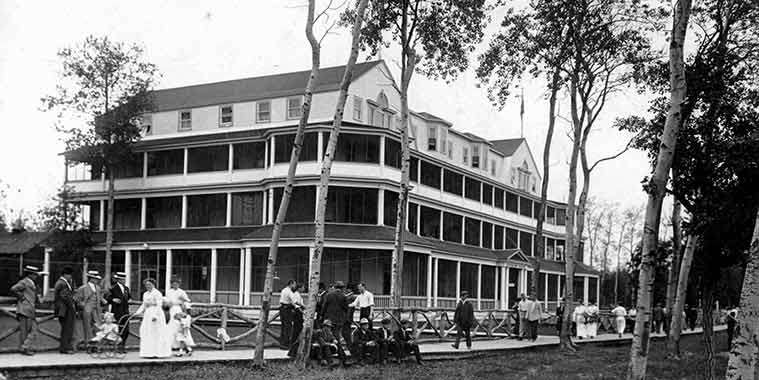Not long after the introduction of excursion trains from Winnipeg to Lake Winnipeg’s beach communities in 1903, thousands of people were visiting each week to escape urban life and a booming tourist industry was created to serve them. Some developers chose to ignore the masses in favour of catering to wealthy vacationers who were not about to rough it despite the remote location.
Dunnottar Yacht Club (1909)
Dunnottar
The first advertisements for the cottage subdivision of Dunnotar Beach appeared in the summer of 1907. The main landowners and drivers of the project were architects Alex and William Melville.
Scottish born and trained, the Melville brothers came to Winnipeg in 1903 and together designed dozens of buildings, mostly in Winnipeg. Today, they are best remembered for their series of early Winnipeg fire halls erected between 1904 and 1914.
The Winnipeg Tribune noted in 1907 that, “The Messrs. Melville are sparing no expense in putting the property in the best possible condition for residents.” This included improvements to the beach area, laying out generous 75x170 foot lots on extra wide streets, and the beginnings of what would become a 200-foot-long pier.
By 1909, development was in full swing and in April the Dunnottar Yacht Club was formed. Its first president was Alex Melville who, on his yacht Dunnottar III, won the previous year’s Boundary Park Cup in the annual three-mile race held on Lake Winnipeg.
The clubhouse, designed by Melville, was advertised as being just a five-minute walk from Ponemah train station and featured a large dining hall, living room and as many as 24 guest rooms.
The first race at the Dunnottar Yacht Club took place on June 26, 1909 and the official opening happened the following Saturday. W. Sanford Evans, Winnipeg’s mayor and a club member, presided over the ceremony which ended with a gala dance and a fireworks display.
The yacht club was short lived. In 1913, the building was rebranded the “Dunnottar House” hotel and operated under that name for a decade. In 1924, it was put up for sale fully furnished and “suitable as a boarding house”.
It is unclear what became of the building.
Empress Hotel
Winnipeg Beach (1908)
What was likely the grandest of Winnipeg Beach’s numerous hotels was the Empress, which opened on June 30, 1908.
The $30,000 venture was financed largely by Edward Windebank. Originally from England, Windebank spent fifteen years in the military with the Royal Engineers before coming to Canada. Between 1905 to 1910 he was manager of the members-only Manitoba Club in Winnipeg.
The three-storey building was designed by Winnipeg architects Hooper and Walker and initially contained around 50 rooms. Another 40 were added for the 1911 season.
The Empress offered all the conveniences of a top city hotel, including electric lights, modern toilets and baths in every room, and a large, formal dining room. It also featured spacious, screened-in verandahs on three sides, “so that the guests may enjoy fresh air and a view of the lake without continual warfare with the mosquitoes.”
Guests could also enjoy the use of the hotel’s lawn bowling green, tennis courts and private beach.
In 1915, the CPR, which invested in the hotel’s construction, enacted a clause in their contract with Windebank that allowed them to buy him out at fair market value. The CPR’s Beach Amusements Ltd. took over and put in Fred M. Thomas as the new manager.
On the afternoon of August 28, 1935, a fire broke out in the roof of the Empress. Despite the best efforts of firefighters, hotel employees and even some guests, the flames reduced the building to ashes in a short time.
The $24,000 loss, believed to be caused by old wiring in the roof, was covered by insurance, but Beach Amusements and the CPR had no appetite to build a new resort hotel.
The New Beach Hotel (1936)
Winnipeg Beach
It was left to the Kelly family to build a replacement for the Empress.
Sam and Hannah Kelly were known in Winnipeg as the long-time operators of the Grain Exchange Building cafeteria. In 1908, Mrs. Kelly purchased Winnipeg Beach’s first large hotel, the circa 1904 King Edward, renamed it the Beach Hotel and managed it in the summers.
The Beach Hotel burned down just three months after the Empress when a fire in an adjoining building destroyed an entire business block of Winnipeg Beach. (It was a bad year for cottage country hotel fires as Lac du Bonnet’s Travellers Hotel was also razed in 1935).
The Kellys decided that they would rebuild the “New Beach Hotel” on the site of the old one.
Designed by architects Over and Munn, the two-storey, 33-room New Beach Hotel was aimed at comfort rather than luxury. Its ads stressed its fireproof stucco exterior, home cooked meals and “an air of homeliness and quiet comfort”, (despite being located across the street from the roller coaster.)
Mrs. Kelly became something of a land baron, also owning a lodge and large cabin rental business. It was said that she could house up to 800 guests in the community at a time.
In 1947, Mrs. Kelly became ill and sold off the hotel that summer. She died in 1950.
The New Beach Hotel still stands and is now known as the Winnipeg Beach Hotel.
Christian writes about local history on his blog, West End Dumplings



